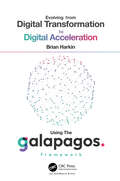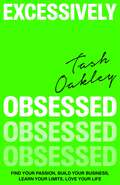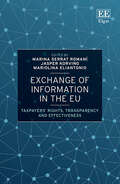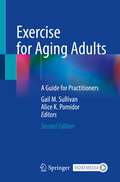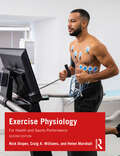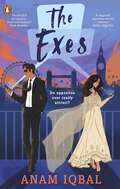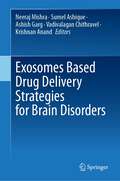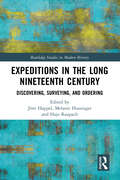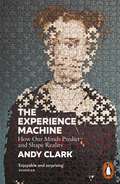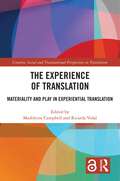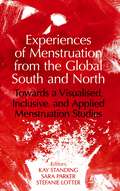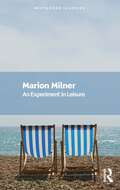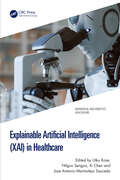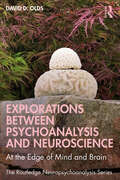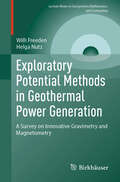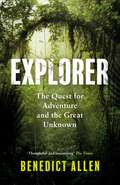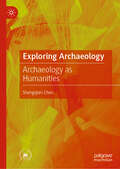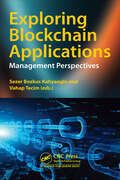- Table View
- List View
Evolving from Digital Transformation to Digital Acceleration Using The Galapagos Framework
by Brian HarkinEvolving from Digital Transformation to Digital Acceleration Using The Galapagos Framework challenges established thinking and offers a new way to deliver digital change. It introduces The Galapagos Framework, which is a new, innovative, and human-centric approach to transformational change. The framework allows organizations to move from digital transformation to digital acceleration, resulting in the creation of exciting and groundbreaking products as well as having a positive impact on the motivation and well-being of their teams.Digital Acceleration is an iterative process that allows organizations to deliver transformations and demonstrate continual progress at pace. Rather than tackling the transformation as one large single event, Digital Acceleration enables organizations to improve one or, at most, two discrete areas of the business quickly and then move onto the next area needing improvement.Presenting a detailed guide to The Galapagos Framework, the book also highlights solutions to common issues, expert case studies, and The Galapagos Roadmap. It discusses how the framework provides the key to increasing productivity, delivery velocity, and performance while reducing cost and complexity, ultimately resulting in digital and business success. The book demonstrates how The Galapagos Framework operates in practice to provide clear solutions to common issues that are classifi ed into Human Elements, Organizational Factors, and the Delivery Aspects. The book also explains why the current approaches to digital transformation are failing and shows how digital leaders and organizations can: Increase productivity Reduce costs Improve delivery performance Reduce operational, financial, and delivery risks Increase profits Deliver digital transformation success
Evolving from Digital Transformation to Digital Acceleration Using The Galapagos Framework
by Brian HarkinEvolving from Digital Transformation to Digital Acceleration Using The Galapagos Framework challenges established thinking and offers a new way to deliver digital change. It introduces The Galapagos Framework, which is a new, innovative, and human-centric approach to transformational change. The framework allows organizations to move from digital transformation to digital acceleration, resulting in the creation of exciting and groundbreaking products as well as having a positive impact on the motivation and well-being of their teams.Digital Acceleration is an iterative process that allows organizations to deliver transformations and demonstrate continual progress at pace. Rather than tackling the transformation as one large single event, Digital Acceleration enables organizations to improve one or, at most, two discrete areas of the business quickly and then move onto the next area needing improvement.Presenting a detailed guide to The Galapagos Framework, the book also highlights solutions to common issues, expert case studies, and The Galapagos Roadmap. It discusses how the framework provides the key to increasing productivity, delivery velocity, and performance while reducing cost and complexity, ultimately resulting in digital and business success. The book demonstrates how The Galapagos Framework operates in practice to provide clear solutions to common issues that are classifi ed into Human Elements, Organizational Factors, and the Delivery Aspects. The book also explains why the current approaches to digital transformation are failing and shows how digital leaders and organizations can: Increase productivity Reduce costs Improve delivery performance Reduce operational, financial, and delivery risks Increase profits Deliver digital transformation success
Excessively Obsessed: Find your passion, build your business, learn your limits, love your life
by Natasha OakleyModern and practical business lessons from Natasha Oakley, co-founder of Monday Swimwear and The Pilates Class Do you have an idea for a business, but no clue where to start? Is there a product or service you're sure you could sell, if only you knew how to file the paperwork or fund the company or build the marketing plan? Do you have an inkling that you'll want to start a business one day - and you can't stop wondering if you have what it takes? Then you have come to the right place.In this empowering guide, Natasha gives an honest account of the blood, sweat and tears that goes into creating a successful business, from registering your company and opening a bank account, all the way to building your team and scaling for growth. Removing the glamour of #hustleculture and the illusion of how easy it might look on social media, Natasha will detail how she bartered jobs and co-founded Monday Swimwear in her living room with her best friend and grew that business (and others) to a multi-million dollar empire. And she will explain how, no matter what your idea, if you are Excessively Obsessed with it, you can do the same. In her book, she will show readers how to: - Harness your idea to create a viable business that has longevity- Know when to leave your job, how to fund your start-up and whether you need a business partner - Generate and grow a huge following - Build contacts when no one knows who you are- Rise above pressures of social media to use it powerfully and with purpose- Create work/life balance to avoid burnout and take care of yourself Excessively Obsessed is for anyone who has ever wondered: should I start my own business? (Spoiler alert: There's no right answer!) And whether you decide to get started tomorrow or give it more time, you'll close this book with a reignited sense of passion and purpose in your career. Through her own story, Natasha will inspire readers to tap into their own unique potential, because when you find your calling, it's worth becoming obsessed.
Exchange of Information in the EU: Taxpayers’ Rights, Transparency and Effectiveness
This timely book provides a holistic analysis of the exchange of information procedures for tax purposes within the EU from an administrative law and tax law perspective. It explores how procedural and substantive taxpayers’ rights are affected by exchange of information processes, and rigorously examines the effectiveness of the current legal framework.Bringing together a diverse array of eminent scholars, the book highlights the importance of the exchange of information process as an essential tool to improve tax authorities' ability to deter, detect and disrupt tax evasion and fraud. Chapters delve into the evolution of the information exchange mechanism, assessing both its application and limits, and deftly analyse the Directive on Administrative Cooperation amendments. They also consider the necessity and effectiveness of continuously widening the tax transparency and exchange of information requirements, identifying possible gaps in judicial protection, and unveiling new avenues for scholarly research.Incisive and authoritative, this book will prove indispensable to researchers, academics, and students of constitutional and administrative law, European law, and tax law and fiscal policy. Legal practitioners and policymakers will also find this book to be a beneficial resource from a governance perspective.
Exercise for Aging Adults: A Guide for Practitioners
by Gail M. Sullivan Alice K. PomidorExercise has been rightly termed the “fountain of youth” for older adults. Exercise is associated with lower risks of developing many chronic conditions (cardiac disease, diabetes mellitus, osteoporosis) as well as being a key treatment modality for common geriatric problems (osteoarthritis, falls, incontinence, sleep issues, frailty). Exercise, or regularly planned physical activity, is also associated with higher functional levels and well-being, which many older adults consider critical for a high quality of life. Indeed, many physiologic changes formerly attributed to senescence appear due to disuse and thus less inevitable than assumed. The dictum of “use it or lose it” holds true, for people 70 years and older. This user-friendly text provides practical strategies for health care professionals who work with or advise older adults to create exercise prescriptions suitable for specific settings and medical conditions. Expanded and revised,the second edition translates new findings in exercise research for the elderly for busy practitioners, trainees, students and administrators and provides practical strategies that can be implemented immediately in the common settings in which practitioners care for adults. It includes key points and case examples which showcase the strong evidence supporting exercise by older adults as a key to enhance health, prevent serious outcomes, such as hospitalization and functional loss, and as part of the treatment plan for diseases that are common in older adults. Strategies and exercises are discussed for specific care settings and illustrated via video examples to ensure readers can immediately apply described techniques.Written by experts in the field, Exercise for Aging Adults is a valuable guide to maintaining quality of life and functional independence from frail to healthy aging adults for physicians, residents in training, medical students, physical therapists, gerontology advance practice nurse practitioners, assisted living facility administrators, directors of recreation, and long-term care directors.
Exercise Physiology: for Health and Sports Performance
by Nick Draper Craig Williams Helen MarshallThis second edition of Exercise Physiology: For Health and Sports Performance brings together all the essential human anatomy and applied physiology that students of exercise science, physical education, and sports coaching will need to know.Written in a friendly, accessible style, and containing a wide range of features to help develop understanding, this book provides a complete one-stop shop for exercise physiology broken down into three fundamental parts: foundations of exercise physiology, applied exercise physiology, and the new Part 3, exercise prescription.With Parts 1 and 2 examining the theory, testing, and practical applications of exercise physiology, the new Part 3 reflects the changes in the field by increasing focus on physical activity and diverse populations and helps provides a more complete course text for any exercise physiology course at universities around the world.This newly revised book is key reading for undergraduate and postgraduate students in the fields of exercise physiology, sports performance, sports therapy, fitness and personal training, and other related sport science courses.
Exercise Physiology: for Health and Sports Performance
by Nick Draper Craig Williams Helen MarshallThis second edition of Exercise Physiology: For Health and Sports Performance brings together all the essential human anatomy and applied physiology that students of exercise science, physical education, and sports coaching will need to know.Written in a friendly, accessible style, and containing a wide range of features to help develop understanding, this book provides a complete one-stop shop for exercise physiology broken down into three fundamental parts: foundations of exercise physiology, applied exercise physiology, and the new Part 3, exercise prescription.With Parts 1 and 2 examining the theory, testing, and practical applications of exercise physiology, the new Part 3 reflects the changes in the field by increasing focus on physical activity and diverse populations and helps provides a more complete course text for any exercise physiology course at universities around the world.This newly revised book is key reading for undergraduate and postgraduate students in the fields of exercise physiology, sports performance, sports therapy, fitness and personal training, and other related sport science courses.
The Exes: An Opposites Attract Romance
by Anam IqbalCan opposites ever really attract? When star-crossed lovers Karim and Zara's worlds collide, they have to work out just how far they’re willing to go to give their love a chance. When Karim and Zara meet, sparks shouldn’t fly.They’ve got nothing in common: Karim - with his on-and offline clique, The Exes - is a globally renowned influencer. Zara is just a normal teen, trying to get into uni, and not bring shame to the family by getting distracted by silly boys.Sparks do fly though. With Zara, Karim can finally let his guard down, while his glamorous world offers Zara an escape from her parent’s control.But someone has their eye on them – a secret gossip who’s been spilling truths about The Exes for years.While Karim and Zara’s dates get swoonier, the blogger’s posts get more personal – and more threatening. Can Karim and Zara unmask their tormentor in time to get their happily ever after? Or does fate have other plans in store for them?
Exosomes Based Drug Delivery Strategies for Brain Disorders
by Neeraj Mishra Sumel Ashique Ashish Garg Vadivalagan Chithravel Krishnan AnandThis book provides a comprehensive overview of the role of exosomes in brain diseases, including stroke, multiple sclerosis, Parkinson's disease, Alzheimer's disease, epilepsy, and depression. It covers the basics of exosome biogenesis, composition, and synthesis, as well as the therapeutic potential of exosomes in brain disorders. The correlation between exosomes and neuroinflammation, the challenges of using exosomes as a novel carrier, and engineered exosomes to deliver therapeutic protein are covered well in this book. Use of radiolabelled exosomes as a diagnostic tool and the toxicity studies of exosomes with potential overcome approaches. It is an essential resource for researchers, clinicians, and healthcare professionals working in the field of exosome research, especially on its applications in brain disorders.
Expeditions in the Long Nineteenth Century: Discovering, Surveying, and Ordering (Routledge Studies in Modern History)
by Jörn Happel Melanie Hussinger Hajo RaupachThis book examines the processes of scientific, cultural, political, technical, colonial and violent appropriation during the 19th century. The 19th century was the century of world travel. The earth was explored, surveyed, described, illustrated, and categorized. Travelogues became world bestsellers. Modern technology accompanied the travelers and adventurers: clocks, a postal and telegraph system, surveying equipment, and cameras. The world grew together faster and faster. Previously unknown places became better known: the highest peaks, the coldest spots, the hottest deserts, and the most remote cities. Knowledge about the white spots of the earth was systematically collected. Those who made a name for themselves in the 19th century are still read today. Alexander von Humboldt or Charles Darwin made the epoch a scientific heyday. Ida Pfeiffer or Isabelle Bird (Bishop) traveled to distant continents and took their readers at home on insightful journeys. Hermann Vámbéry or Sir Richard Burton got to know the most remote languages and regions. There are countless travel reports about a fascinating century, which, with surveying and exploration, also brought colonial conquest and exploitation into the world. In ten individual studies, the authors explore travelers from all over the world and analyze their successes. The unifying element of all the studies is the experience of distance and its communication by means of travelogues to the armchair travelers who have stayed at home.This volume will be of value to students and scholars both interested in modern history, social and cultural history, and the history of science and technology.
Expeditions in the Long Nineteenth Century: Discovering, Surveying, and Ordering (Routledge Studies in Modern History)
This book examines the processes of scientific, cultural, political, technical, colonial and violent appropriation during the 19th century. The 19th century was the century of world travel. The earth was explored, surveyed, described, illustrated, and categorized. Travelogues became world bestsellers. Modern technology accompanied the travelers and adventurers: clocks, a postal and telegraph system, surveying equipment, and cameras. The world grew together faster and faster. Previously unknown places became better known: the highest peaks, the coldest spots, the hottest deserts, and the most remote cities. Knowledge about the white spots of the earth was systematically collected. Those who made a name for themselves in the 19th century are still read today. Alexander von Humboldt or Charles Darwin made the epoch a scientific heyday. Ida Pfeiffer or Isabelle Bird (Bishop) traveled to distant continents and took their readers at home on insightful journeys. Hermann Vámbéry or Sir Richard Burton got to know the most remote languages and regions. There are countless travel reports about a fascinating century, which, with surveying and exploration, also brought colonial conquest and exploitation into the world. In ten individual studies, the authors explore travelers from all over the world and analyze their successes. The unifying element of all the studies is the experience of distance and its communication by means of travelogues to the armchair travelers who have stayed at home.This volume will be of value to students and scholars both interested in modern history, social and cultural history, and the history of science and technology.
The Experience Machine: How Our Minds Predict and Shape Reality
by Andy ClarkA grand new vision of cognitive science that explains how our minds build our worlds‘One of the most important books yet published this century’ SpectatorFor as long as we've studied the mind, we've believed that information flowing from our senses determines what our mind perceives. But as our understanding has advanced in the last few decades, a hugely powerful new view has flipped this assumption on its head. The brain is not a passive receiver, but an ever-active predictor.At the forefront of this cognitive revolution is widely acclaimed philosopher and cognitive scientist Andy Clark, who has synthesized his ground-breaking work on the predictive brain to explore its fascinating mechanics and implications. Among the most stunning of these is the realization that experience itself, because it is guided by prior expectation, is a kind of controlled hallucination. We don't passively take in the world around us; instead our mind is constantly making and refining predictions about what we expect to see. This even applies to our bodies, as the way we experience pain and other states is shaped by our expectations, and this has broader implications for the understanding and treatment of conditions from PTSD to schizophrenia to medically unexplained symptoms. From the most mundane experiences to the most sublime, it is our predictions that sculpt our experience.A landmark study of cognitive science, The Experience Machine lays out the extraordinary explanatory power of the predictive brain for our lives, mental health and society.
The Experience of Translation: Materiality and Play in Experiential Translation (Creative, Social and Transnational Perspectives on Translation)
by Madeleine CampbellCampbell, Vidal and their contributors expand the notion of translation beyond linguistic, modal and medial borders to embrace posthumanist perspectives through a holistic experiential epistemology which envisions translation as engaged, situated social practice.The first of two volumes, this book focuses on questions of materiality and play. Drawing together contributions on theory, methodology and practice from translators, scholars and practitioners working in the creative and performing arts, this book explores how contemporary, experiential acts of interpretation, mediation and negotiation can serve to bridge social and cultural discontinuities across time and space. These range from ancestral past to digital present, from rural to urban environments across the globe. Experiential translation applies a transdisciplinary lens to problematize views of translation and untranslatability traditionally bound by structuralist frames of reference and the reserve of professional linguistic translation. The chapters in this book apply this experiential lens to understand a pluriverse of creative translation practices where the translator’s subject position in relation to the ‘original’ is transformed by the role of experimentation, creativity and play. This book and its companion volume The Translation of Experience: Cultural Artefacts in Experiential Translation will be of particular interest to translators and arts practitioners, scholars and researchers in the transdisciplinary field of humanities.Funding: This work was supported by UKRI under AHRC Grant AH/V008234/1, awarded to Ricarda Vidal, King’s College London (Principal Investigator) and Madeleine Campbell, University of Edinburgh (Co-Investigator).
The Experience of Translation: Materiality and Play in Experiential Translation (Creative, Social and Transnational Perspectives on Translation)
by Madeleine Campbell Ricarda VidalCampbell, Vidal and their contributors expand the notion of translation beyond linguistic, modal and medial borders to embrace posthumanist perspectives through a holistic experiential epistemology which envisions translation as engaged, situated social practice.The first of two volumes, this book focuses on questions of materiality and play. Drawing together contributions on theory, methodology and practice from translators, scholars and practitioners working in the creative and performing arts, this book explores how contemporary, experiential acts of interpretation, mediation and negotiation can serve to bridge social and cultural discontinuities across time and space. These range from ancestral past to digital present, from rural to urban environments across the globe. Experiential translation applies a transdisciplinary lens to problematize views of translation and untranslatability traditionally bound by structuralist frames of reference and the reserve of professional linguistic translation. The chapters in this book apply this experiential lens to understand a pluriverse of creative translation practices where the translator’s subject position in relation to the ‘original’ is transformed by the role of experimentation, creativity and play. This book and its companion volume The Translation of Experience: Cultural Artefacts in Experiential Translation will be of particular interest to translators and arts practitioners, scholars and researchers in the transdisciplinary field of humanities.Funding: This work was supported by UKRI under AHRC Grant AH/V008234/1, awarded to Ricarda Vidal, King’s College London (Principal Investigator) and Madeleine Campbell, University of Edinburgh (Co-Investigator).
Experiences of Menstruation from the Global South and North: Towards a Visualised, Inclusive, and Applied Menstruation Studies (Proceedings of the British Academy)
by KAY STANDING, SARA PARKER, AND STEFANIE LOTTERExperiences of Menstruation from the Global South and North is an edited collection that presents menstruation across the life course, from menarche to menopause. It takes a multidisciplinary perspective, based on academic research, activism, and creative work, to look at the varied and diverse lived experiences of menstruators across the Global South and North. Beyond the biological facts of menstruation, there is little we can agree upon in a global context where culture determines what menstruation is, what consequences it has for the individual, and how it is best managed. The lived experience of menstruators is inextricably entangled with the body, cultured concepts of gender, religion, economics, and of course, life itself. This volume unpacks concepts in a poly-vocal approach, highlights creative and transformative methods, and expands menstrual health and hygiene management discourses to emphasise structural issues of gender inequality, politics, and human rights.
An Experiment in Leisure (Routledge Classics)
by Marion Milner'Before I began this experiment I had always been haunted by the feeling that the surface of life, what everyone said about it, was quite different from the reality of life, that the important things that were happening all the time were on the whole quite different from what was said about them.' - Marion MilnerWhat is it that stops people from knowing what they want? How much of our experience is shaped by images, symbols, and early memories – and do such things help or hinder one becoming an adult? Written in 1936, An Experiment in Leisure continues Marion Milner’s unique and compelling investigation into how we lead our lives, complementing the account she began in A Life of One’s Own.Attempting to understand the gap between what she memorably describes as ‘the poverty of words and the reality of living’, she draws on memory images – in books, mythology, religious experience, travel, and even going to the theatre – that seem to point to a suspension of ordinary, everyday awareness. From this state of emptiness springs an increasing imaginative appreciation of being alive and, as Milner concludes, of being a woman.With a new Foreword by Akshi Singh, An Experiment in Leisure remains a striking and captivating adventure in thinking and living with uncertainty, whose insights remain fresh and relevant today.
An Experiment in Leisure (Routledge Classics)
by Marion Milner'Before I began this experiment I had always been haunted by the feeling that the surface of life, what everyone said about it, was quite different from the reality of life, that the important things that were happening all the time were on the whole quite different from what was said about them.' - Marion MilnerWhat is it that stops people from knowing what they want? How much of our experience is shaped by images, symbols, and early memories – and do such things help or hinder one becoming an adult? Written in 1936, An Experiment in Leisure continues Marion Milner’s unique and compelling investigation into how we lead our lives, complementing the account she began in A Life of One’s Own.Attempting to understand the gap between what she memorably describes as ‘the poverty of words and the reality of living’, she draws on memory images – in books, mythology, religious experience, travel, and even going to the theatre – that seem to point to a suspension of ordinary, everyday awareness. From this state of emptiness springs an increasing imaginative appreciation of being alive and, as Milner concludes, of being a woman.With a new Foreword by Akshi Singh, An Experiment in Leisure remains a striking and captivating adventure in thinking and living with uncertainty, whose insights remain fresh and relevant today.
Explainable Artificial Intelligence (Biomedical and Robotics Healthcare)
by Utku Kose Nilgun Sengoz Xi Chen Marmolejo Saucedo, Jose AntonioThis book highlights the use of explainable artificial intelligence (XAI) for healthcare problems, in order to improve trustworthiness, performance and sustainability levels in the context of applications.Explainable Artificial Intelligence (XAI) in Healthcare adopts the understanding that AI solutions should not only have high accuracy performance, but also be transparent, understandable and reliable from the end user's perspective. The book discusses the techniques, frameworks, and tools to effectively implement XAI methodologies in critical problems of healthcare field. The authors offer different types of solutions, evaluation methods and metrics for XAI and reveal how the concept of explainability finds a response in target problem coverage. The authors examine the use of XAI in disease diagnosis, medical imaging, health tourism, precision medicine and even drug discovery. They also point out the importance of user perspectives and value of the data used in target problems. Finally, the authors also ensure a well-defined future perspective for advancing XAI in terms of healthcare.This book will offer great benefits to students at the undergraduate and graduate levels and researchers. The book will also be useful for industry professionals and clinicians who perform critical decision-making tasks.
Explainable Artificial Intelligence (Biomedical and Robotics Healthcare)
This book highlights the use of explainable artificial intelligence (XAI) for healthcare problems, in order to improve trustworthiness, performance and sustainability levels in the context of applications.Explainable Artificial Intelligence (XAI) in Healthcare adopts the understanding that AI solutions should not only have high accuracy performance, but also be transparent, understandable and reliable from the end user's perspective. The book discusses the techniques, frameworks, and tools to effectively implement XAI methodologies in critical problems of healthcare field. The authors offer different types of solutions, evaluation methods and metrics for XAI and reveal how the concept of explainability finds a response in target problem coverage. The authors examine the use of XAI in disease diagnosis, medical imaging, health tourism, precision medicine and even drug discovery. They also point out the importance of user perspectives and value of the data used in target problems. Finally, the authors also ensure a well-defined future perspective for advancing XAI in terms of healthcare.This book will offer great benefits to students at the undergraduate and graduate levels and researchers. The book will also be useful for industry professionals and clinicians who perform critical decision-making tasks.
Explorations Between Psychoanalysis and Neuroscience: At the Edge of Mind and Brain (The Routledge Neuropsychoanalysis Series)
by David D. OldsExplorations Between Psychoanalysis and Neuroscience brings together the life's work of David Olds, pioneering psychoanalyst, psychiatrist, philosopher, and key figure in neuropsychoanalysis.Throughout the chapters, the reader is taken on a journey through Olds' theories on psychoanalysis and neuroscience as he develops new ways of examining the brain and human thought. Olds instills in the reader the importance of taking an interdisciplinary approach to psychoanalysis, psychiatry and working with patients. He expands upon his philosophical background and integrates evolutionary biology, neurobiology, cognitive science and semiotics to show the importance of dual aspect monism in neuropsychoanalysis. The theories developed by Olds and presented in this volume will help analysts working with patients facing issues with memory, affect, consciousness, cognition and trauma, among other difficulties.This book will be essential reading to psychoanalysts and psychiatrists, as well as anybody interested in neuropsychoanalysis and the importance of an interdisciplinary approach to analytic thinking and practice.
Explorations Between Psychoanalysis and Neuroscience: At the Edge of Mind and Brain (The Routledge Neuropsychoanalysis Series)
by David D. OldsExplorations Between Psychoanalysis and Neuroscience brings together the life's work of David Olds, pioneering psychoanalyst, psychiatrist, philosopher, and key figure in neuropsychoanalysis.Throughout the chapters, the reader is taken on a journey through Olds' theories on psychoanalysis and neuroscience as he develops new ways of examining the brain and human thought. Olds instills in the reader the importance of taking an interdisciplinary approach to psychoanalysis, psychiatry and working with patients. He expands upon his philosophical background and integrates evolutionary biology, neurobiology, cognitive science and semiotics to show the importance of dual aspect monism in neuropsychoanalysis. The theories developed by Olds and presented in this volume will help analysts working with patients facing issues with memory, affect, consciousness, cognition and trauma, among other difficulties.This book will be essential reading to psychoanalysts and psychiatrists, as well as anybody interested in neuropsychoanalysis and the importance of an interdisciplinary approach to analytic thinking and practice.
Exploratory Potential Methods in Geothermal Power Generation: A Survey on Innovative Gravimetry and Magnetometry (Lecture Notes in Geosystems Mathematics and Computing)
by Willi Freeden Helga NutzThe book provides the geoscientific context, that arises in gravimetric/magnetometric exploration. It essentially uses mathematics as a key technology for modeling issues on the basis of analysis and interpretation according to dense and precise gravitational/magnetic measurements. It is dedicated to surface and deep geology with potential data primarily of terrestrial origin. The book spans the interdisciplinary arc from geoengineering, especially geodesy, via geophysics to geomathematics and geology, and back again. It presents the recently published pioneering and groundbreaking multiscale mollifier methodologies realizing the bridging transfer from gravitational/magnetic measurements to approximative/numerical mollifier wavelet decorrelations with novel geologic prospects and layer-structure determination as outcome. Using the specific example of the German Saarland region, new important fields of application, especially for areas with mining-related cavities, will be opened up and subjected to an in-depth geologic detection.
Explorer: The Quest for Adventure and the Great Unknown
by Benedict AllenWhat does it mean to be an explorer in the twenty-first century? This is the story of what first led Benedict Allen to head for the farthest reaches of our planet – at a time when there were still valleys and ranges known only to the remote communities who inhabited them. It is also the story of why, thirty years later, he is still exploring. Benedict decides to journey back to a clouded mountain in New Guinea to find an old friend called Korsai, and to fulfil a promise they made as young men. Explorer tells the story of what it means to be ‘lost’ and ‘found’.
Exploring Archaeology: Archaeology as Humanities
by Shengqian ChenThis book looks inward to reveal and analyse problems in archaeology itself. The subject explored in this volume include: humanistic attributes of archaeology, various archaeological theory, challenges in the development of archaeology, China Archaeology paradigms and "Chinese School", responsibilities and status of archaeology in society, and prospects of Archaeology in China. With years of engagement in philosophy and theory studies, the author raised many bold questions and contributed unique and original views. While the archaeological circle remained tacit about -"Chinese School"- a term proposed by leading authority Professor Su Bingqi, the author bravely voiced that archaeology needs a "Chinese school". The "Chinese school" would facilitate both the reconstruction of cultural significance and the vying for international discourse power. The author also puts forward his thoughts on the current public archaeological fever, explaining and reflecting on the social responsibility, discourse power and how to present the archaeological discovery in a more accurate and efficient way to the public.
Exploring Blockchain Applications: Management Perspectives
by Sezer Bozkus Kahyaoglu Vahap TecimIn this book, the development process of blockchain algorithms and examples of their applications in different sectors are explored. The opportunities and challenges of blockchain implementations that arise in making technological innovations usable in corporate structures are discussed. In this respect, the book aims to deal with both the conceptual framework and the real challenges and opportunities encountered in practice regarding the blockchain applications. It is tried to contribute to the literature by presenting practical blockchain application suggestions to the readers on a scientific basis.It is a fact that blockchain technology is considered one of the most disruptive and revolutionary innovations after the invention of the internet. Blockchain technology, which was first used for cross-border payments, is coming up with a new application area in a different sector every day. The main purpose of Blockchain-based systems is to spread the "trust" service provided by a central intermediary to machines in transactions between two parties. Thus, it removes the need for this trust from the monopoly of a single intermediary. Blockchain implementation scenarios are to establish math-based trust in an untrusted environment.While exploring the complexity of blockchain applications in different sectors, the emerging risks are also examined from a management perspective. In particular, it is aimed to be a key work that the management levels of the enterprises can benefit from in the decision-making processes.It will be seen that blockchain technologies will be used unlimitedly in design, planning, management and decision making. This book will also introduce new visions for practitioners to use different blockchain technologies and methodologies to face problems.
